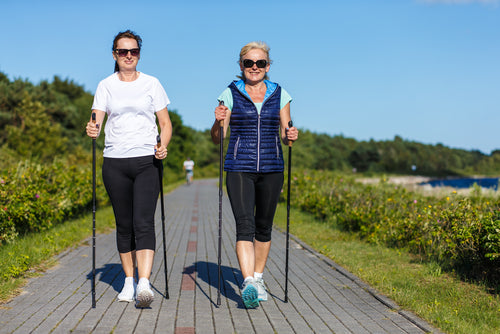Exercising with Lymphedema: Essential Tips, Lymphedema Products and More
Lymphedema is a condition that occurs when one limb or part of the body swells. It may occur spontaneously, but it’s usually triggered by damage to the lymph nodes, surgery, chemotherapy and other medical events. Lymphedema may be chronic, and it can be mild or severe. While lymphedema cannot be cured, there are many ways to manage the symptoms.
Combined with the right lymphedema products and precautions, exercising can help manage lymphedema symptoms. Physical movement causes the muscles to contract, squeezing the lymph and encouraging it to keep circulating instead of pooling in one place. Exercise also strengthens your body, which makes it less vulnerable to injury, infection and other potential lymphedema triggers.
However, exercise routines must be undertaken carefully, as the wrong kind of exertion can cause injury and may trigger lymphedema symptoms. Here are some tips for exercising with lymphedema:

Check with your doctor first.
If you’re already at risk for lymphedema due to surgery, cancer treatment or another medical event, you should talk to your doctor about how to prevent lymphedema and when it’s appropriate for you to begin exercising. Your doctor will be able to advise you on how much rest and recovery you need, what types of exercises to do and what intensity to aim for. Even if you feel great, wait until you have the all-clear to begin exercising, as working the affected area prematurely can actually cause lymphedema.
Partner with a therapist or other lymphedema expert.
Your doctor may have the resources and skills necessary to help you put together a comprehensive exercise plan to manage your lymphedema. If not, consider working with a physical medicine doctor, physical therapist, occupational therapist or other expert who specializes in lymphedema management. They’ll have a deep well of exercises to draw from and will help you put together an exercise routine that’s tailored to your individual needs. For instance, exercise programs for a patient with lymphedema in their right arm might not work for a patient with lymphedema in their left leg.

Start slow and easy and build from there.
You don’t try to run a marathon the week after a heart attack, so you shouldn’t jump into the deep end of exercise too soon after your lymphedema manifests. If you’ve never worked out before, you’ll need to start slow, and if you were very active before treatment, you’ll have to work back up to your previous levels of performance. For example, you might need to lift lighter weights or run a shorter distance at a slower pace. While this may be frustrating in the short term, it’s worth it to reduce or avoid lymphedema symptoms in the long run.
Keep a sharp eye out for symptoms.
Lymphedema symptoms may not appear right away, and this is true for physical exertion as well as other triggers. During and after exercise, check your body for changes in size, shape, tissue, texture, soreness, heaviness or firmness, and pay special attention to any limbs or areas that are especially vulnerable. If you feel any pain or notice any swelling during exercise, stop immediately and cool down. If your symptoms are very extreme, contact your doctor immediately.

Do a mix of activities
To avoid over straining part of your body and to reap the maximum benefits of exercise, you’ll want to rotate through different types of workouts. The three main categories are aerobic exercise, strength training and flexibility and stretching exercises. Aerobic exercise works your heart and lungs, strengthening your cardiovascular system, while strength training builds your muscles and bones. Finally, flexibility and stretching exercises help you to stay limber and recover from other kinds of exercises. These exercises can take many forms—for instance, swimming, running and biking are all cardiovascular exercises. Your doctor or therapist will be able to help you figure out the ideal mix of exercises.
If you struggle with swelling or bad circulation during exercise, compression wraps and other lymphedema products can help manage the symptoms and promote a full range of motion. Many people find lymphedema wraps to be especially beneficial since the fit can be adjusted throughout the day. To learn more about what lymphedema products are available, browse both our upper body compression and lower body compression collections.
Kaki Zell - Vice President of Sales, Marketing, eCommerce at Legs-4-Life LLC Kaki holds a Bachelor of Science degree in Business Administration and Management from Virginia Polytechnic Institute and State University. She’s been working in the medical device industry for over 11 years and currently serves on the Board of Directors for the Greensboro Science Center.

